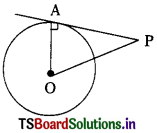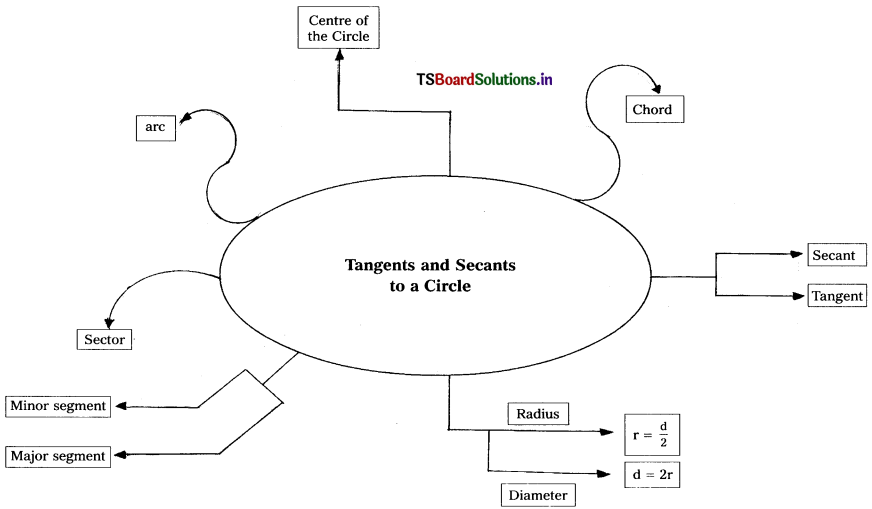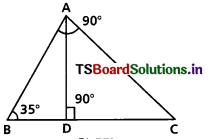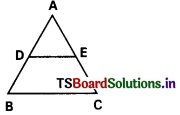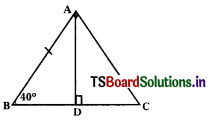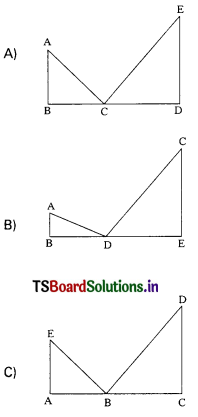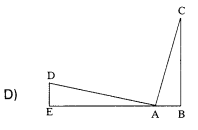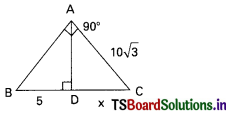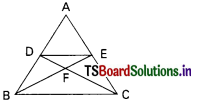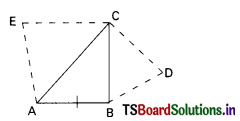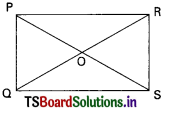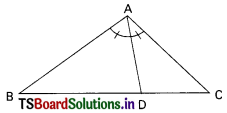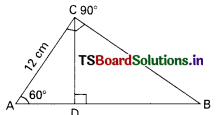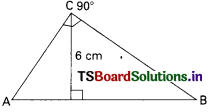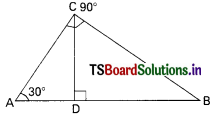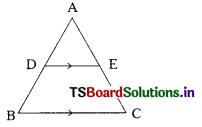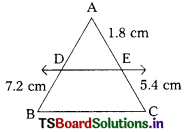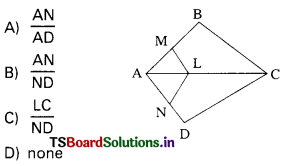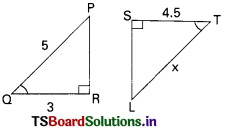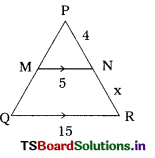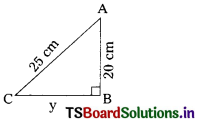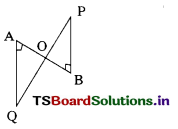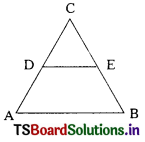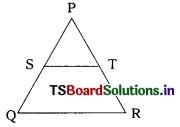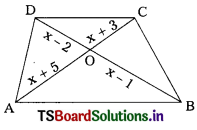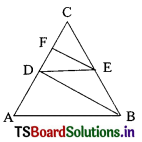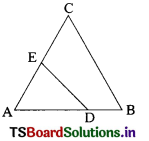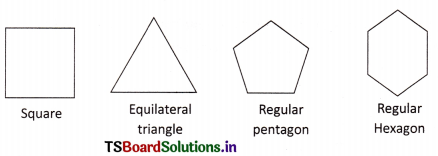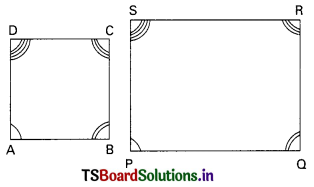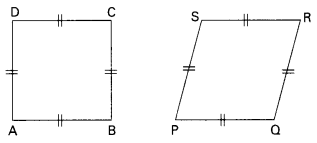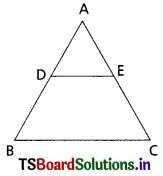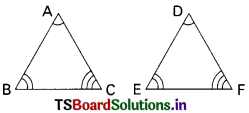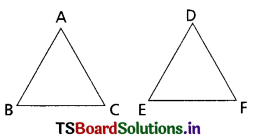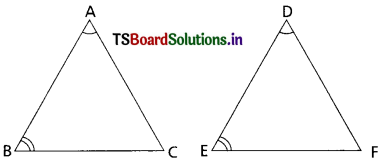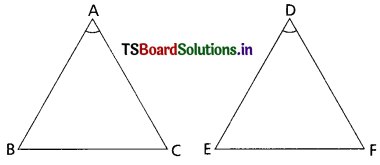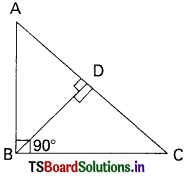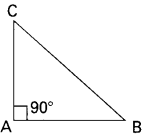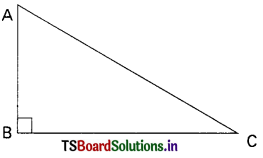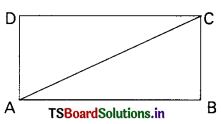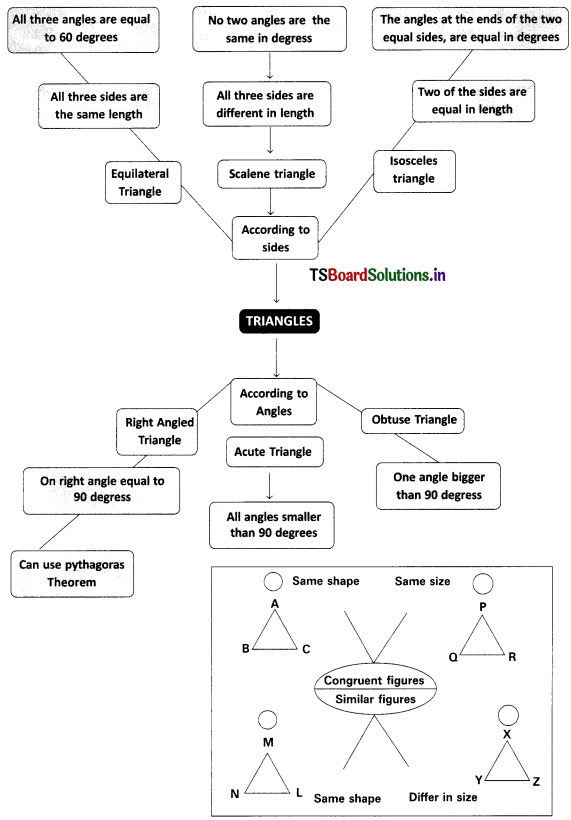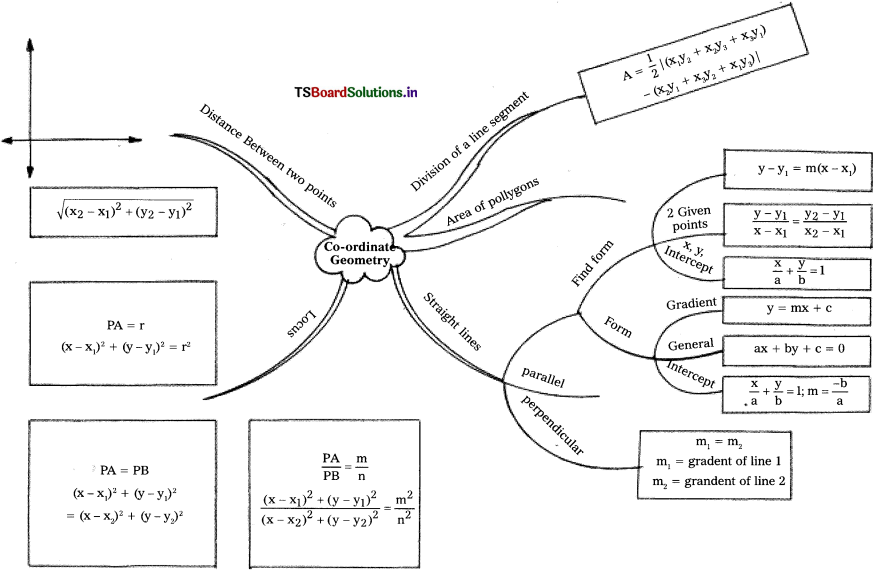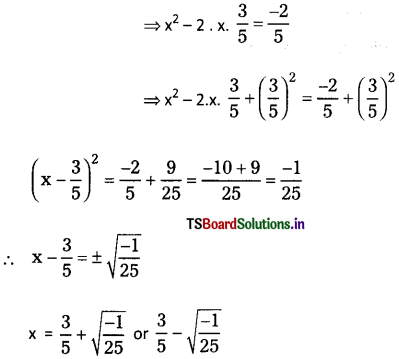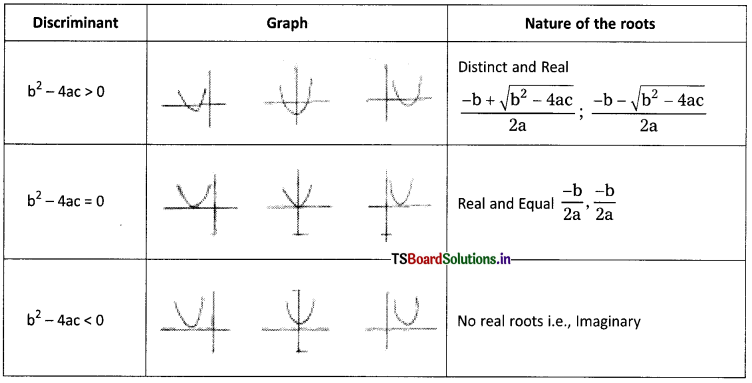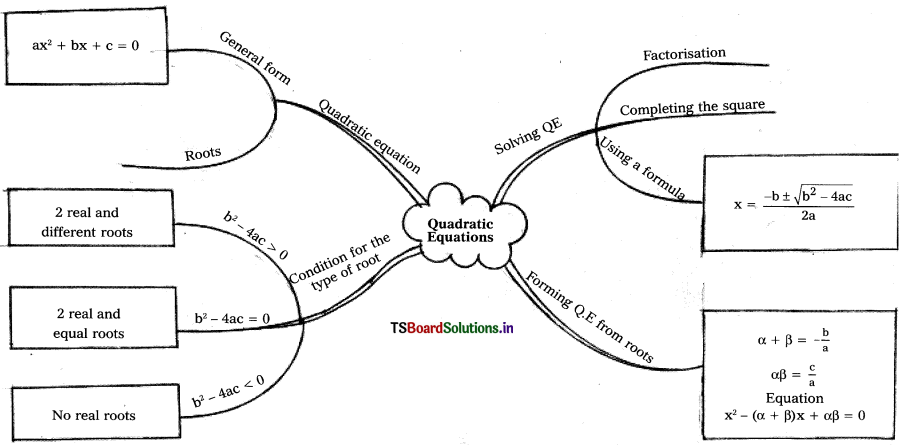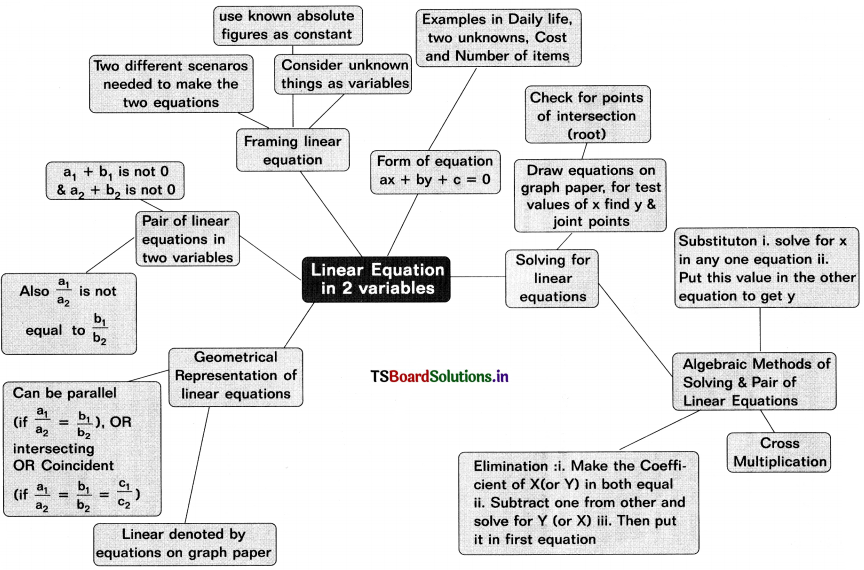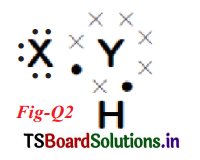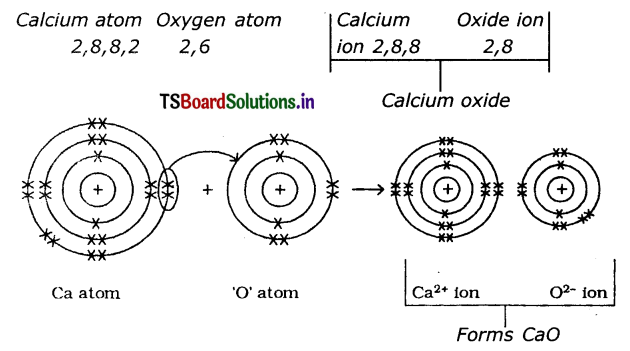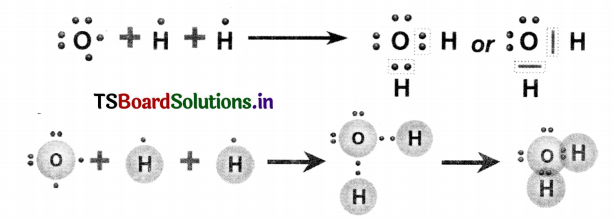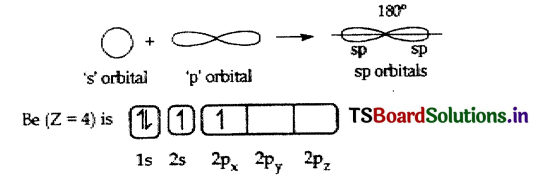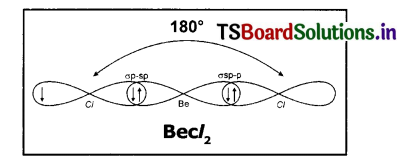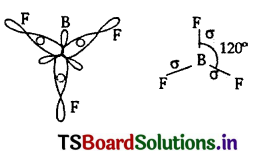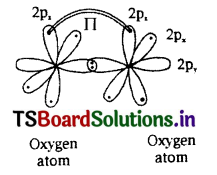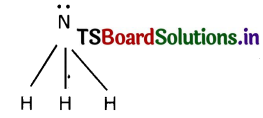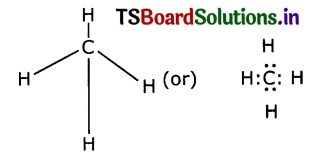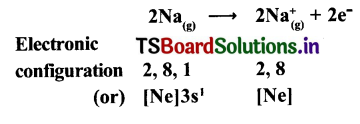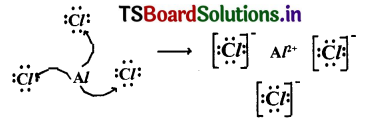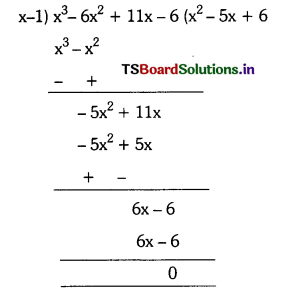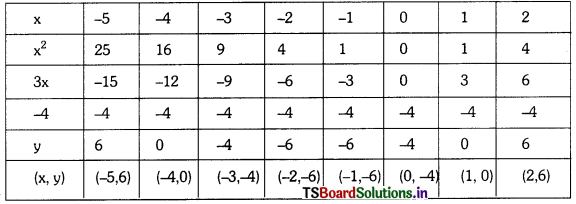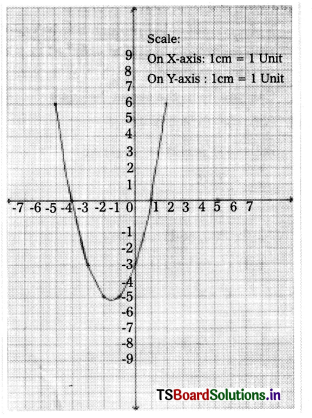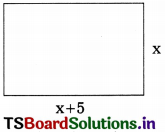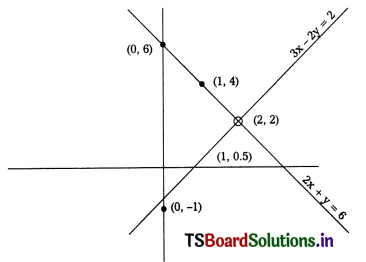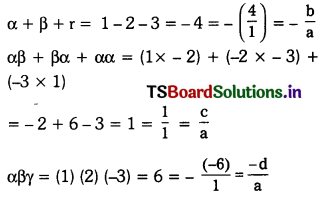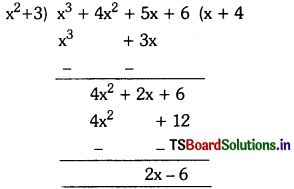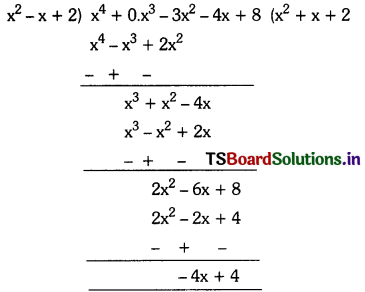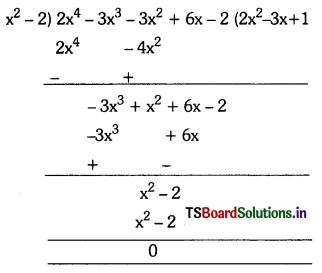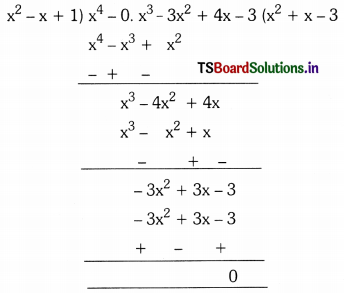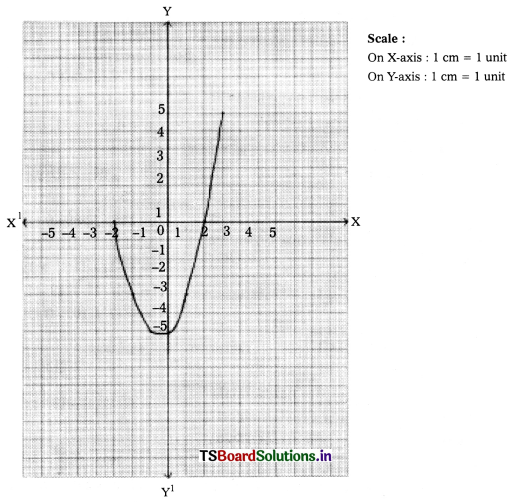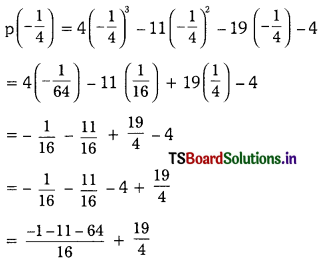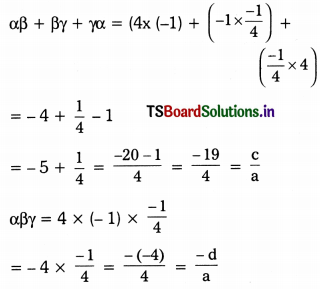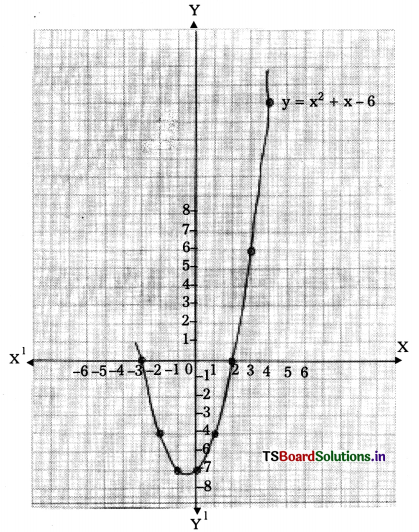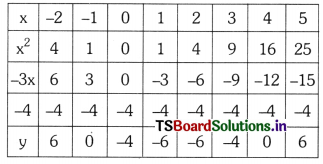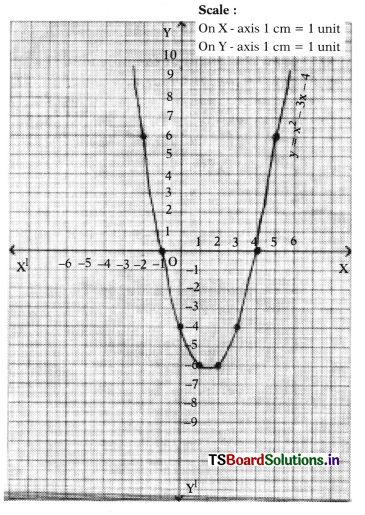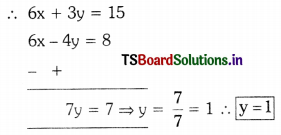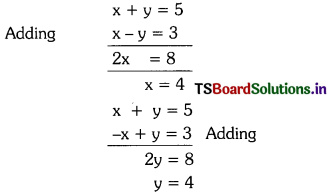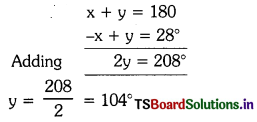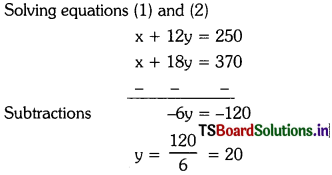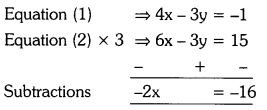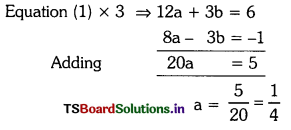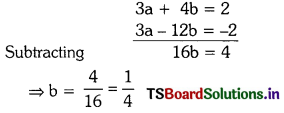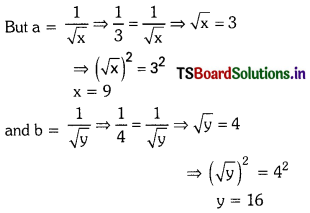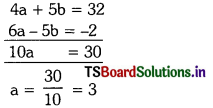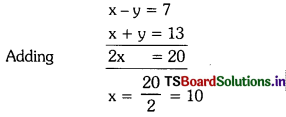Solving these TS 10th Class Maths Bits with Answers Chapter 9 Tangents and Secants to a Circle Bits for 10th Class will help students to build their problem-solving skills.
Tangents and Secants to a Circle Bits for 10th Class
Question 1.
The angle between the tangent to a circle and the radius drawn through the point of contact is
A) 90°
B) 60°
C) 45°
D) 30°
Answer:
A) 90°
Question 2.
From a point P, length of the tangent to a circle is 12 cm and the distance of P from the centre is 13 cm. then the radius of circle is
A) 7 cm
B) 6 cm
C) 5 cm
D) 12.5 cm
Answer:
C) 5 cm
Question 3.
If the tangents PA and PB from a point P to a circle with centre ‘O’ are inclined to each other at an angle of 80° then ∠POA = …………..
A) 50°
B) 60°
C) 70°
D) 80°
Answer:
A) 50°

Question 4.
If TP and TQ are two tangents to a circle with centre ‘O’ so that ∠POQ = 110°, then ∠PTQ =
A) 60°
B) 70°
C) 80°
D) 90°
Answer:
B) 70°
Question 5.
In the adjacent figure, if quadrilateral PQRS circumscribes a circle then PB + SD = ………………

A) SR
B) PR
C) QS
D) PS
Answer:
D) PS
Question 6.
In the adjacent figure, APB is a tangent to the circle with centre ‘O’ at a point P. If ∠QPB = 50° then the measure of ∠POQ =
A) 25°
B) 75°
C) 100°
D) 120°

C) 100°
Question 7.
In the adjacent figure AB, BC and AC of a triangle ABC, touch a circle at P, Q and R respectively. If PA = 4 cm, BP = 6 cm and AC = 11cm then length of BC =
A) 15 cm
B) 14 cm
C) 7 cm
D) 10 cm
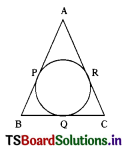
Answer:
D) 10 cm
Question 8.
In the adjacent figure, if BP = 5 cm, QC = 7 cm and AR = 6 cm then AB + BC + AC =
A) 18 cm
B) 36 cm
C) 25 cm
D) 30 cm
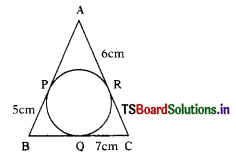
Answer:
B) 36 cm
Question 9.
The length of the tangent drawn from a point 17 cm away from the centre of a circle of radius 8 cm is
A) 25 cm
B) 9 cm
C) 15 cm
D) 8.5 cm
Answer:
C) 15 cm

Question 10.
In the adjacent figure, the length of the chord AB if PA = 6 cm and ∠PAB = 60° is
A) 5 cm
B) 6 cm
C) 7 cm
D) 4 cm
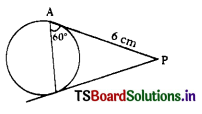
Answer:
B) 6 cm
Question 11.
A line which intersects a circle in two points is called
A) a secant
B) a tangent
C) a chord
D) an arc
Answer:
A) a secant
Question 12.
The number of tangents that can be drawn to a circle at any point on it is
A) 2
B) 1
C) 3
D) infinetly many
Answer:
B) 1
Question 13.
The number of parallel tangents that can be drawn to a circle can have at the most is
A) 1
B) 2
C) 3
D) 4
Answer:
B) 2

Question 14.
The number of tangents that can be drawn to a circle from outside the circles is
A) 2
B) 1
C) infinetly many
D) 4
Answer:
A) 2
Question 15.
Two concentric circles of radii 5 cm and 3 cm. Find the length of the chord of the larger circle which touches the smaller circle
A) 10 cm
B) 6 cm
C) 8 cm
D) 2 cm
Answer:
C) 8 cm
Question 16.
Length of the arc of a quadrant of a circle of radius ‘r’ is
A) πr
B) 3πr
C) \(\frac{\pi \mathrm{r}}{2}\) + 2r
D) \(\frac{\pi \mathrm{r}}{2}\)
Answer:
D) \(\frac{\pi \mathrm{r}}{2}\)
Question 17.
The length of the arc A × B in the adjacent figure is
A) 11 cm
B) 22 cm
C) 33 cm
D) 44 cm
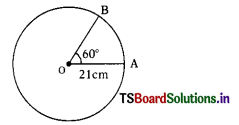
Answer:
B) 22 cm

Question 18.
The area of a sector of a circle of radius 7 cm and central angle 45° is
A) 5.5 cm2
B) 19.25 cm2
C) 154 cm2
D) 77 cm2
Answer:
B) 19.25 cm2
Question 19.
The measure of central angle of a circle
A) 90°
B) 180°
C) 170°
D) 360°
Answer:
D) 360°
Question 20.
In the adjacent figure, ‘O’ is the centre of the circle. The area of the sector OAPB is \(\frac{5}{18}\) part of the area of the circle. Then the value
A) 30°
B) 60°
C) 45°
D) 100°
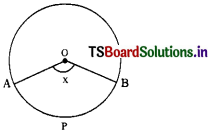
Answer:
D) 100°
Question 21.
A tangent PQ at a point P of a circle of radius 5 cm meets a line through the centre O at a point Q so that OQ = 12 cm, then PQ =
A) \(\sqrt{79}\)
B) \(\sqrt{119}\)
C) 119
D) 169
Answer:
B) \(\sqrt{119}\)

Question 22.
The number of parallel tangents of a circle with a given tangent is
A) 1
B) 2
C) 3
D) 4
Answer:
A) 1
Question 23.
The length of the tangent drawn from an exterior point is 8 cm away from the centre of a circle of radius 6 cm is
A) 8 cm
B) 10 cm
C) 6 cm
D) 12 cm
Answer:
B) 10 cm
Question 24.
In the figure x = ………………
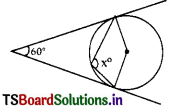
A) 60°
B) 100°
C) 110°
D) 120°
Answer:
D) 120°
Question 25.
The semi perimeter of ∆ABC = 28 cm then AF + BD + EC is …………………..
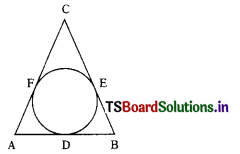
A) 23 cm
B) 28 cm
C) 56 cm
D) 14 cm
Answer:
B) 28 cm
Question 26.
The length of the drawn from a point 8 cm away from the centre of circle with radius 6 cm is
A) 2\(\sqrt{7}\) cm
B) 3\(\sqrt{7}\) cm
C) \(\sqrt{7}\) cm
D) 10 cm
Answer:
A) 2\(\sqrt{7}\) cm

Question 27.
In the figure ‘O’ is the centre of the circle and PA, PB are tangents, then their lengths are,
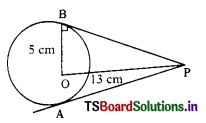
A) 5 cm, 13 cm
B) 13 cm, 13 cm
C) 13 cm, 12 cm
D) 12 cm, 12 cm
Answer:
D) 12 cm, 12 cm
Question 28.
Angle in a major segment is
A) an obtuse angle
B) an acute angle
C) right angle
D) none
Answer:
B) an acute angle
Question 29.
The length of the tangent drawn to a circle with radius ‘r’ from a point P which is ‘d’ units from the centre is
A) \(\sqrt{d^2-r^2}\)
B) \(\sqrt{r^2+d^2}\)
C) \(\sqrt{d r}\)
D) \(\sqrt{d + r}\)
Answer:
A) \(\sqrt{d^2-r^2}\)
Question 30.
If the arc is a minor arc then the segment is a …………………. segment
A) Minor
B) Major
C) Semi-circle
D) None
Answer:
A) Minor

Question 31.
The radius of a circle is equal to the sum of the circumferences of two circles of diameters 36 cm and 20 cm is ……………
A) 16 cm
B) 28 cm
C) 42 cm
D) 56 cm
Answer:
B) 28 cm
Question 32.
If tangents PA and PB from a point P to a circle with centre ‘O’ are inclined to each other at an angle of 110° then ∠PAO =
A) 45°
B) 50°
C) 70°
D) 35°
Answer:
D) 35°
Question 33.
How many tangent lines can be drawn to a circle from a point outside the circle ?
A) 1
B) 4
C) 2
D) none
Answer:
B) 4
Question 34.
In the given figure ∠APB = 60° and OP = 10 cm. then PA = …………….. cm. (A.P. Mar. ’16, ’15)
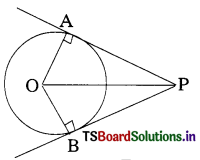
A) 5
B) 5\(\sqrt{2}\)
C) 5\(\sqrt{3}\)
D) 20
Answer:
C) 5\(\sqrt{3}\)

Question 35.
The maximum number of possible tangents that can be drawn to a circle is ……………. (A.P. Mar. ’15)
A) infinity
B) 2
C) 4
D) 1
Answer:
A) infinity
Question 36.
The angle between the tangent and the radius drawn at the point of contact is ………………. (A.P. June ’15)
A) 60°
B) 30°
C) 45°
D) 90°
Answer:
D) 90°
Question 37.
If a circle is inscribed in a Quadrilateral then AB + CD = …………….. (A.P. June ’15)
A) BC + DA
B) AC + BD
C) 2AC + 2BD
D) 2BC + 2DA
Answer:
A) BC + DA
Question 38.
In the adjoint figure AC = 5, So BC = ………………… cm. (A.P. June ’15)

A) 5 cm
B) 7.5 cm
C) 2.5 cm
D) 10 cm
Answer:
C) 2.5 cm
Question 39.
The angle made at the centre of a circle is ………………. (A.P. Mar. ’16)
A) 360°
B) 90°
C) 280°
D) 60°
Answer:
A) 360°

Question 40.
The number of secants that can be drawn to a circle is ………………… (T.S. Mar. ’16)
A) 2
B) 1
C) infinity
D) 0
Answer:
C) infinity
Question 41.
The diameter of a circle is 10.2 cm then its radius is ……………… cm. (A.P. Mar. ’16)
A) 5.1 cm
B) 20.4
C) 10.5
D) 15.3
Answer:
A) 5.1 cm
Question 42.
If ‘r’ is the radius of a semi-circle then its perimeter is ………………….
A) πr + 2r (or) r[π + 2] (or) \(\frac{36}{7}\) r
B) πr + r
C) πr + 3r
D) πr
Answer:
A) πr + 2r (or) r[π + 2] (or) \(\frac{36}{7}\) r
Question 43.
Which of the following is not correct? (A.P. Mar. ’16 )
i) Maximum possible tangents that can be drawn to a circle from a point ‘p’ is 2.
ii) The number of secants drawn to a circle from a point at exterior is 2.
A) i only
B) ii only
C) i and ii
D) neither (i) nor (ii)
Answer:
A) i only

Question 44.
In the figure PT is a tangent to the circle with centre O’ then x = ………………….
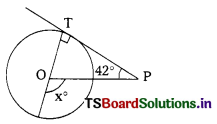
A) 148°
B) 58°
C) 52°
D) 42°
Answer:
D) 42°
Question 45.
Angle in a major segment is …………………
A) an obtuse angle
B) an acute angle
C) right angle
D) none
Answer:
B) an acute angle
Question 46.
In the figure PT is a tangent drawn from P. If the radius is 7 cm and OP is 25 cm, then the length of the tangent is ………………. cm.
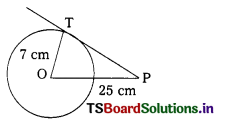
A) 18
B) 20
C) 24
D) 26
Answer:
C) 24
Question 47.
PQ is the chord of a circle. The tangent XR drawn at X meets PQ at R when produced. If XR = 12 cm, PQ = x cm, QR = (x – 2) cm. then x = ………………..
A) 6 cm
B) 7 cm
C) 14 cm
D) 10 cm
Answer:
D) 10 cm

Question 48.
The angle between the tangent to a circle and the radius drawn through the point of contact is ………………
A) 90°
B) 60°
C) 45°
D) 30°
Answer:
A) 90°
Question 49.
Two circles intersect at A, B, PS, PT are two tangents drawn from P which lies on AB to the two circles, then ……………..
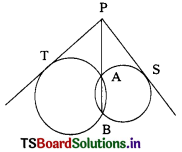
A) PS = 2PT
B) PT = 2PS
C) PS = PT
D) PS ≠ PT
Answer:
C) PS = PT
Question 50.
In the figure AB is a diameter and AC is chord of the circle such that ∠BAC = 30°. If DC is a tangent, then ABCD is ……………..
A) isosceles
B) equilateral
C) right angled
D) acute angled
Answer:
A) isosceles
Question 51.
To draw a pair of tangents to a circle which are inclined to each other at an angle of 60° it is required to draw the tangents at the end points of two radii inclined at an angle of ……………….
A) 30°
B) 60°
C) 90°
D) 120°
Answer:
D) 120°

Question 52.
If the radii of two concentric circles are 5 cm and 13 cm then the length of the chord of one circle which is tangent to the other circle is ……………
A) 24 cm
B) 18 cm
C) 12 cm
D) 6 cm
Answer:
A) 24 cm
Question 53.
If tangents PA and PB from a point P to a circle with centre O are inclined to each other at an angle of 110° then ∠PAO = …………….
A) 45°
B) 50°
C) 70°
D) 35°
Answer:
D) 35°
Question 54.
In a right triangle ABC, right angled at B, BC = 15 cm and AB = 8 cm. A circle is inscribed in the triangle ABC. The radius of the circle is ……………..
A) 1cm
B) 3 cm
C) 5 cm
D) 2 cm
Answer:
B) 3 cm
Question 55.
Three circles are drawn with the vertices of a triangle as centres such that each circle touches the other two. If the sides of the triangle are 2 cm, 3 cm, 4 cm find the diameter of the smallest circle.
A) 4 cm
B) 2 cm
C) 1 cm
D) 5 cm
Answer:
C) 1 cm

Question 56.
A circle may have ……………… parallel tangents atmost.
A) 10
B) 12
C) 9
D) 2
Answer:
D) 2
Question 57.
A tangent to a circle intersects it in ………………. point(s).
A) 1
B) 2
C) 3
D) 4
Answer:
A) 1
Question 58.
A line segment joining any point on a circle is called its ………………..
A) diameter
B) tangent
C) chord
D) none
Answer:
C) chord
Question 59.
A line which intersects the given circle at two distinct points is called a ……………….
A) tangent
B) secant
C) circle
D) centre
Answer:
B) secant

Question 60.
The common point to a tangent and a circle is called …………………
A) point of contact
B) circle
C) tangent
D) none
Answer:
A) point of contact
Question 61.
Angle between the tangent and radius drawn through the point of contact is ……………..
A) 100°
B) 70°
C) 80°
D) 90°
Answer:
D) 90°
Question 62.
The circumference of a circle is 100 cm. The side of a square inscribed in the circle is ……………… cm.
A) \(\frac{1}{\pi}\)
B) \(\frac{5 \sqrt{2}}{\pi}\)
C) \(\frac{50 \sqrt{2}}{\pi}\)
D) 50\(\sqrt{2}\)
Answer:
C) \(\frac{50 \sqrt{2}}{\pi}\)
Question 63.
The area of a square inscribed in a circle of radius 8 cm is …………………… cm2.
A) 118
B) 129
C) 160
D) 128
Answer:
D) 128

Question 64.
The area of a circle that can be inscribed in a square of side 6 cm is …………………… cm2.
A) 9π
B) 12π
C) 120π
D) none
Answer:
A) 9π
Question 65.
The perimeter of a quadrant of a circle of radius \(\frac{7}{2}\) cm is …………………. cm.
A) 9.5
B) 12.5
C) 10.5
D) 2
Answer:
B) 12.5
Question 66.
The number of tangents at one point of a circle is ………………..
A) 1
B) 2
C) 3
D) 10
Answer:
A) 1
Question 67.
Number of tangents to a circle which are parallel to a secant are …………………
A) 1
B) 10
C) 9
D) 2
Answer:
D) 2

Question 68.
………………. tangent can be drawn from a point inside a circle.
A) No
B) 1
C) 4
D) None
Answer:
A) No
Question 69.
A line which is perpendicular to the radius of the circle through the point of contact is called a …………………..
A) secant
B) tangent
C) chord
D) none
Answer:
B) tangent
Question 70.
The tangents drawn at the ends of a diameter are ………………
A) parallel
B) 0
C) perpendicular
D) none
Answer:
B) 0
Question 71.
The tangent drawn at the end point of radius is ………………….
A) 0
B) parallel
C) perpendicular
D) none
Answer:
C) perpendicular

Question 72.
Tangents drawn from an exterior point are ……………..
A) not equal
B) parallel
C) equal
D) none
Answer:
C) equal
Question 73.
A secant meets a circle in ……………… points.
A) 2
B) 4
C) 3
D) 1
Answer:
A) 2
Question 74.
A tangent meets a circle in ……………… points.
A) 10
B) 9
C) 7
D) 1
Answer:
D) 1
Question 75.
Sum of the central angles in a circle is ………………..
A) 360°
B) 300°
C) 180°
D) 110°
Answer:
A) 360°

Question 76.
Angle is a semi-circle at the centre is …………………….
A) 100°
B) 180°
C) 200°
D) 80°
Answer:
B) 180°
Question 77.
From the figure, x = ……………… cm.
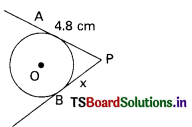
A) 8.4
B) 8.8
C) 4.8
D) 4
Answer:
C) 4.8
Question 78.
Angle in a semi-circle is ……………..
A) 80°
B) 90°
C) 100°
D) 110°
Answer:
B) 90°
Question 79.
Number of tangents drawn to a circle is ……………….
A) 1
B) 4
C) 3
D) infinite
Answer:
D) infinite

Question 80.
In the figure, x = ……………….. cm.

A) 5
B) 6
C) 8.2
D) 10
Answer:
A) 5
Question 81.
Angle in a minor segment is ………………
A) acute
B) 60°
C) obtuse
D) none
Answer:
C) obtuse
Question 82.
In a circle d = 10.2 cm then r = …………… cm.
A) 4.1
B) 5.1
C) 4.6
D) 5.6
Answer:
B) 5.1
Question 83.
The longest chord in a circle is ……………..
A) diameter
B) radius
C) chords
D) none
Answer:
A) diameter

Question 84.
Circles having same centre are called ……………. circles.
A) triangle
B) concentric
C) trapezium
D) none
Answer:
B) concentric
Question 85.
Circles having same radii are ………………
A) congruent
B) not congruent
C) only similar
D) none
Answer:
A) congruent
Question 86.
Area of circle is ………….. sq. units.
A) \(\frac{\pi}{\mathrm{r}^2}\)
B) πr3
C) πr2
D) π2r2
Answer:
C) πr2
Question 87.
The shaded portion represents ……………….

A) minor segment
B) major segment
C) chord
D) none
Answer:
A) minor segment

Question 88.
Area of semi-circle is ……………….
A) πr2
B) π2 r
C) \(\frac{\pi \mathrm{r}^2}{2}\)
D) πr
Answer:
C) \(\frac{\pi \mathrm{r}^2}{2}\)
Question 89.
Number of circle passing through 3 collinear points in a plane is ……………….
A) 1
B) 0
C) 9
D) 12
Answer:
B) 0
Question 90.
Sum of opposite angles in a cyclic quadrilateral is …………….
A) 100°
B) 180°
C) 190°
D) 200°
Answer:
B) 180°
Question 91.
Cyclic rhombus is a ………………
A) rhombus
B) parallelogram
C) triangle
D) none
Answer:
A) rhombus

Question 92.
In the figure, ∠BAC = ………………
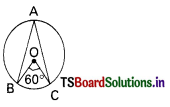
A) 90°
B) 70°
C) 30°
D) none
Answer:
C) 30°
Question 93.
Area of sector = ……………….
A) \(\frac{x^{\circ}}{360}\) × πr2
B) \(\frac{x^{\circ}}{360}\) × 2πr
C) lb
D) none
Answer:
A) \(\frac{x^{\circ}}{360}\) × πr2
Question 94.
Area of ring = ……………….
A) π(R2 – r2)
B) π(R – r)
C) R2 – r2
D) π(R2 – r2 + 2r)
Answer:
A) π(R2 – r2)

Question 95.
Side of a square is 4 cm then A = ……………….. cm2.
A) 64
B) 12
C) 16
D) 20
Answer:
C) 16
Question 96.
Diameter of a circle passes through ……………
A) equal
B) point
C) centre
D) none
Answer:
C) centre
Question 97.
The shaded portion represents …………… segment.
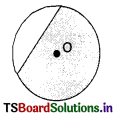
A) major
B) minor
C) acute
D) none
Answer:
A) major
Question 98.
Which of the following is a semicircle ?
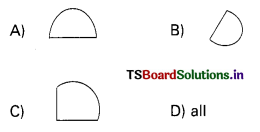
Answer:
(A)
Question 99.
Angles in the same segment of the circle ………………
A) 30°
B) equal
C) not equal
D) none
Answer:
B) equal

Question 100.
In the figure, x° = …………
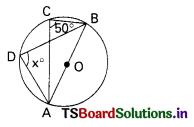
A) 30°
B) 110°
C) 60°
D) none
Answer:
D) none
Question 101.
In the figure, x = …………………
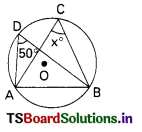
A) 20°
B) 90°
C) 60°
D) 80°
Answer:
C) 60°
Question 102.
Area of triangle = ………………. sq.units.
A) bh
B) \(\frac{1}{2}\)bh
C) \(\frac{\mathrm{b}+\mathrm{h}}{2}\)
D) none
Answer:
B) \(\frac{1}{2}\)bh

Question 103.
Area of square whose is 3 cm in …………………… cm2.
A) 6
B) 12
C) 10
D) 9
Answer:
D) 9
Question 104.
Area of circle with radius r = …………………
A) πr4
B) πr
C) πr2
D) \(\frac{\pi}{2}\)
Answer:
C) πr2
Question 105.
The area of square is 49 cm2 then side is …………….. cm.
A) 12
B) 6
C) 8
D) 7
Answer:
D) 7
Question 106.
In the above problem perimeter = ……………. cm.
A) 19
B) 16
C) 28
D) none
Answer:
C) 28

Question 107.
Angle made by minute hand in 1 m = ………………..
A) 6°
B) 12°
C) 10°
D) none
Answer:
A) 6°
Question 108.
x° = 60°, r = 14 cm then area of sector = ………………. cm2.
A) 100.6
B) 102.66
C) 811.6
D) none
Answer:
B) 102.66
Question 109.
Area of regular hexagon of side ‘a’ units is ……………… sq. units.
A) \(\frac{6 \sqrt{3}}{4}\)a2
B) \(\frac{6 \sqrt{3}}{7}\)a2
C) \(\frac{6}{7} \sqrt{3}\)a2
D) none
Answer:
A) \(\frac{6 \sqrt{3}}{4}\)a2
Question 110.
Parallelogram circumscribing a circle is a ……………
A) parallelogram
B) rhombus
C) circle
D) none
Answer:
B) rhombus

Question 111.
In the figure, XY and X1Y1 are two parallel tangents to a circle with centre ‘O’ and another tangent AB with point of contact C intersecting XY at A and X1Y1 at B then ∠AOB = ………………..

A) 75°
B) 95°
C) 70°
D) 90°
Answer:
D) 90°
Question 112.
The angle between a tangent to a circle and the radius drawn at the point of contact is ……………….
A) 60°
B) 70°
C) 90°
D) 20°
Answer:
C) 90°
Question 113.
If AP and AQ are the two tangents to a circle with centre ‘O’. So that POQ = 110° then ∠PAQ = ……………..
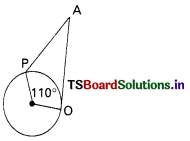
A) 70°
B) 60°
C) 65°
D) 75°
Answer:
A) 70°
Question 114.
Area of circle interms of diameter is ……………..
A) \(\frac{\pi \mathrm{d}^2}{4}\)
B) πr2
C) \(\frac{\pi \mathrm{d}^2}{14}\)
D) all
Answer:
A) \(\frac{\pi \mathrm{d}^2}{4}\)

Question 115.
In the figure, AP = 12 cm, PB = 16 cm and π = 3.14 then perimeter of shaded region is …………………… cm.
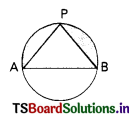
A) 51
B) 70
C) 58
D) 68
Answer:
C) 58
Question 116.
A bicycle wheel makes 75 revolutions per minute to maintain a speed of 8.91 km per hour then diameter of the wheel is ………………. m.
A) 6.3
B) 0.63
C) 8.1
D) none
Answer:
B) 0.63
Question 117.
Angle described by hour hand in 12 hours is ………………….
A) 90°
B) 200°
C) 360°
D) 180°
Answer:
C) 360°
Question 118.
Each angle in a square is …………….
A) 85°
B) right angle
C) 60°
D) 70°
Answer:
B) right angle

Question 119.
In the figure, the area of shaded region is ……………… cm2.
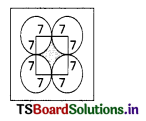
A) 74
B) 60
C) 82
D) 42
Answer:
D) 42
Question 120.
Perimeter of semicircle is ………… units.
A) \(\frac{36 \mathrm{r}}{7}\)
B) \(\frac{18}{7}\)r
C) \(\frac{9}{17}\)r
D) none
Answer:
A) \(\frac{36 \mathrm{r}}{7}\)
Question 121.
In the figure the relation among a, b and c is ………………
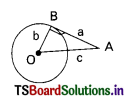
A) c2 = a2 + b2
B) c2 – a2 = 2b2
C) c2 + b2 = a2
D) all
Answer:
A) c2 = a2 + b2
Question 122.
In the figure, a = ……………….
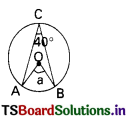
A) 100°
B) 170°
C) 80°
D) 90°
Answer:
C) 80°
Question 123.
Perimeter of sectors = …………….
A) l + 2r
B) l – r
C) l – 2r
D) none
Answer:
A) l + 2r
Question 124.
What do you observe from the below
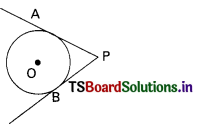
A) PA < PB B) PA > PB
C) PA = PB
D) none
Answer:
C) PA = PB

Question 125.
The radius of a circle is doubled then its area becomes ……………… times.
A) 5
B) 4
C) 9
D) none
Answer:
B) 4
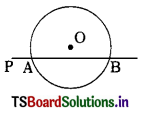
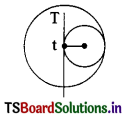
![]()
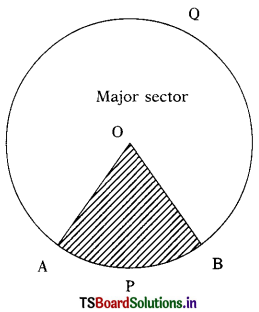
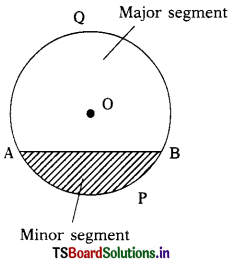
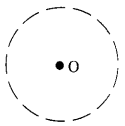
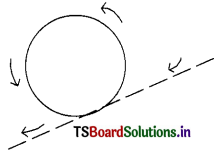
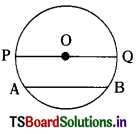


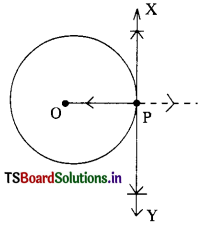
![]()
